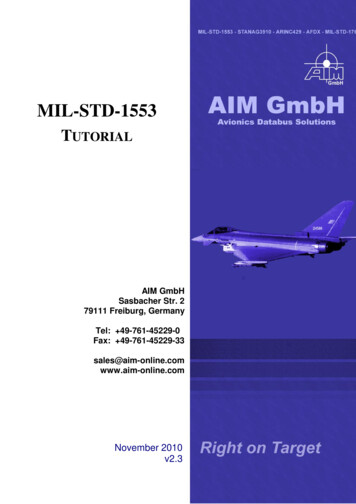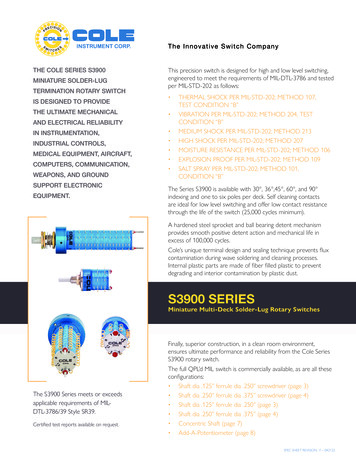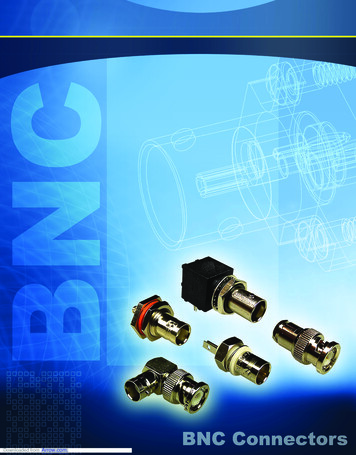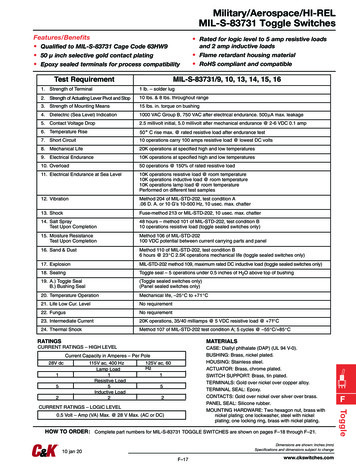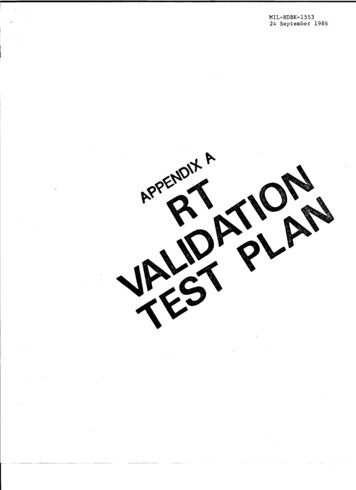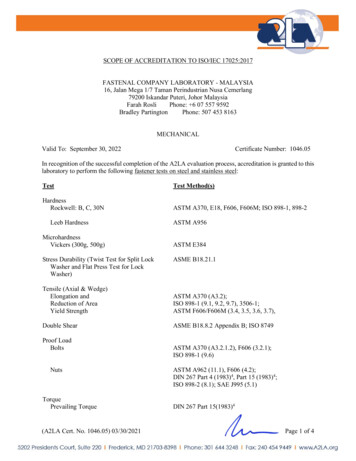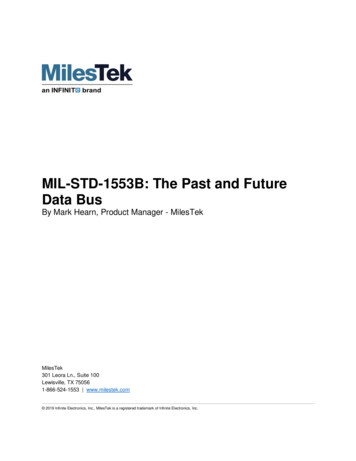
Transcription
Considerations When SelectingMIL-STD-1553B ComponentsBy MilesTekMilesTek301 Leora Ln., Suite 100Lewisville, TX 750561-866-524-1553 www.milestek.com 2019 Infinite Electronics, Inc., MilesTek is a registered trademark of Infinite Electronics, Inc.
IntroductionThe interconnected backbone of a MIL-STD-1553B vehicle depends on the electrical and mechanicalreliability of the components, the design, and the installation. With the vast array of MIL-STD-1553Bspecified sub-assemblies, there are factors that can go overlooked for passive components such ascouplers, cables, and connectors. Often built with kilometers of wiring, aircraft in particular can be difficultto troubleshoot and must be inspected frequently for potential failures such as intermittent connections,shorts, and corrosion. Still, these passive components that make up the network can be individuallyassessed to operate with a high level of integrity.Bus Couplers ConsiderationsMIL-STD-1553B specifies that data bus coupler must be placed between the main data bus and thevehicle subsystems, computer system, or terminal in order to protect the integrity of the entire network.The data bus coupler is often called a ‘stub coupler’ where a ‘stub’ is simply a pair of wires connectingavionics components to the main bus. MIL-STD-1553B and STANAG 3838 further specifies that eachstub coupler come equipped with fault isolation resistors and a step-up transformer (1:1.41) to avoidshorts, improve common mode rejection, and provide lightning immunity for the terminals connected tothe bus.Balancing the Amount of Couplers and the Distance between ThemWhile bus couplers are necessary to protect the internal wiring and circuitry, they inevitably add a degreeof mismatch. The main bus (often 78 Ω twinax) has a consistent impedance along the transmission lineuntil a stub where the discontinuity causes an abrupt change in impedance resulting in reflections andloss. MIL-STD-1553B specifies that the longest stub length is 20 feet for transformer coupled stubs inorder to minimize the impedance load on the main bus. Still, this number can be exceeded as there is adelicate balance in introducing loads on the bus in order to achieve the specified signal-to-noise ratio andsystems error rate performance as specified in MIL-HDBK-155A.The effect the stub has on the bus waveform depends on the rise/fall time as compared to the time ittakes for a wave to propagate from the bus to the end of the stub and back. The reflection can occurbefore the waveform has changed, causing waveform distortions. In essence, a high impedance of thecoupling stub can minimize signal distortion but since this impedance is reflected back to the main bus,the impedance has to be kept below a certain threshold in order to deliver an adequate amount of powerat the receiving end. The total load and total characteristic impedance can potentially have an adverseeffect on the performance of an installation. Oftentimes, it is desirable to have reserve couplers in order toaccess extra remote devices whenever deemed necessary. Still, the hazard that the extra load can causemakes it so that reserve couplers are not used in a bus line system unless absolutely required [4].In-Line Stub CouplerIn-line couplers are spliced directly into the main bus cable, this allows for small form factors and weightsavings when compared to the box style stub coupler, these couplers can be conveniently rolled up inwiring bundles without the need to preplan the arrangement of couplers. Highly integrated wiring systemswww.milestek.com 1-866-524-1553 2019 Infinite Electronics, Inc.,MilesTek is a registered trademark of Infinite Electronics, Inc.2
in small aircraft may require in-line couplers dueto their limited weight requirements to maintainthe desired power-to-weight ratio. This comeswith the cost of modularity as the in-line stubs areoften difficult to repair/replace in the case of afailure due to a lack of transformer integrity wherethe windings could be open or shorted. Duringinstallation, a complete cable harness cannot bedismantled and reorganized due to unexpectedcircumstances (damage during fitting) by theoperators in charge of fitting the equipment-potentially costing more in time and pushing backdeadlines for aircraft construction. This can beinhibit productivity on the industrial scale as theexact arrangement of the aircraft componentsand interconnections must be thoroughly gaugedin order for the whole process to run smoothly.In-line couplers have the benefit of high reliabilityand space savings with the tradeoff of flexibilityduring installations and overhauls.Box Stub CouplerBoxed couplers can be an asset in that they are relatively simple install and replace thereby mitigatingany hassle that can occur upon installation. Still, designers must plan for mounting points for couplers andtheir respective wiring as the bulky housing occupies much more space and weight. The splicingnecessary to install a boxed coupler is more unreliable as there are far more connections between thebulkhead connectors on the box and the clamp/solder or crimp joints of the wiring. These connections canquickly fatigue under the duress of an aircraft’s high vibration environment increasing the mean timesbetween failures (MTBF). MTBF is a direct measure of a system’s reliability based on known failure ratesof subassemblies in a 1553B network, this indicator is also directly proportional to the number ofcomponents and joints between each component. In the occurrence of a fault, technicians connect busanalyzers to the twisted shielded pair bus and twist and wring the wires in order to locate the source ofthe short. This can further damage the bus wires posing another potential risk for failure to a networkinstallation [1].Couplers housed in boxes allow for a highly modular configuration in aircraft but the increase in connectionscan decrease their level of reliability as compared to in-line stubs.www.milestek.com 1-866-524-1553 2019 Infinite Electronics, Inc.,MilesTek is a registered trademark of Infinite Electronics, Inc.3
Multi-Port CouplersSince there is no specification for the minimum distance between stubs on a bus, multiple stub outputcouplers are employed to connect to a tight grouping of avionics to potentially save space, weight, andimprove MTBF as this solutions limits the amount of individual stubs necessary. While these also come inin-line form factors for intricately designed aircraft wiring, the box style couplers have the benefit of savingon space while maintaining modularity and ease of installation and repair.Harness ConsiderationsCable LengthTypically, most of the cable runs in a 1553B installation consists of the main bus, or, a twisted shieldedpair with an impedance between 70 Ω and 85 Ω (typically 78 Ω). The maximum attenuation specified forthe cabling is 1.5 dB/100 feet at 1 MHz, for longer cable runs a lower attenuation is necessary. In otherwords, the maximum length of the bus is directly correlated to the gauge of the inner conductors and timedelay of the transmitted signal.According to MIL-HDBK-1553A Section 40.6.1, when a signal’s propagation delay is more than 50% ofthe rise or fall time, it becomes necessary to consider transmission line effects such as attenuation. Theaverage rise time of a 1553B signal is 1.6 nanoseconds/foot so a 100 foot bus would have a 160nanosecond propagation delay.Twinaxial Cable Electrical ConsiderationsTwinaxial cables are normally leveraged for the main data bus in a 1553B network, this is due to theireffectiveness for short-range, high-speed, differential signaling applications up to 15 MHz. A minimum of90% coverage is specified in MIL-STD-1553B for enhanced RF/electromagnetic interference (RFI/EMI)protection. While the two balanced signals running through the twisted pair cancels any randomly inducednoise picked up through the copper braid, optimizing the braid and dielectric of the twinax can still greatlyimprove some of its electrical characteristics. Braiding can be made of a variety of metal alloys but copperstill has the best conductivity and therefore provides higher coverage, the coverage can be furtherimproved to up to 93% by weaving the braid tighter. This level of craftsmanship in the manufacturingprocess can enhance performance without leveraging any extra materials. Another option to improveperformance is to add an additional dielectric filler to separate the braid from the twisted pair and lowerleakage capacitance to ground, this is especially useful in long runs where the longer conductors have ahigher capacitance.Twinaxial cables have balanced conductors that leverage differential signaling where any external commonmode noise can easily get canceled. Additionally 1553B twinaxial cables require a minimum of 90%coverage, further increasing noise immunity.www.milestek.com 1-866-524-1553 2019 Infinite Electronics, Inc.,MilesTek is a registered trademark of Infinite Electronics, Inc.4
Triaxial Cable Electrical ConsiderationsTypically used for sensitive and wideband systems where noise voltages arising from stray powersources is of concern such video and high frequency data circuits, triaxial cables are more similar to acoaxial cable with an extra layer of dielectric and shielding. The grounded outer braid adds the ability topass both ground loop and capacitive field noise currents from the internal coax. At high frequencies, thecable reduces the shield surface transfer impedance due to the isolation and decoupling between the twobraids [5]. While this additional layer provides greater bandwidth and interference rejection, it is moreexpensive than the twinax and coax and so is typically used in specialized systems such as lowimpedance laser lamps and exploding bridge (EBW) ordinance systems [6].Discrete triaxial cabling is leveraged for specialized high frequency applications where the second layer ofshielding is chassis ground while the inner braid functions as the return path for the signal. This providesprotection from common-mode interference.Multiple Signal Harnessing ConsiderationsThe interconnections between avionics equipment often require the use of cable harnesses for multiplediscrete signals. These cables require extra care so that the signals transmitted are not interrupted orobscured by external noise. Oftentimes, twisted shielded pairs are leveraged for the benefits of differentialmode transmission where common-mode signals can be readily distinguished and canceled as well asadded shielding to provide EMI protection. The shielding is then stripped back and the twisted pairunfurled in order to crimp or solder connector pins and ground the shielding (or generate another pin). Forthe isolation of signals, when a number of signals pass through a single connector wires that carry similarsignals are often laced separately in the harness. In some cases multiple floating shields have thepotential to cause ground loops and can be avoided by being properly terminated with conductiveRFI/EMI backshell adapters and large compression rings.www.milestek.com 1-866-524-1553 2019 Infinite Electronics, Inc.,MilesTek is a registered trademark of Infinite Electronics, Inc.5
Multi-pin cable harnesses that route discrete signals between avionics equipment often use twisted shieldedpairs with triaxial connector pin inserts as the concentricity ensures the polarity of cables from two differentvendors are not reversed.Source: http://www.navair.navy.mil/index.cfm?fuseaction home.NAVAIRNewsStory&id 5594Cable Jacketing and InsulationWhile the electrical performance of the harnessing is critical, the mechanical reliability of the cabling canbe just as relevant in the performance of a data bus. Cable jacketing is the first line of defense of a cablefrom harsh environments and temperature extremes. Military cables are often designed to withstandtemperatures between -55oC to 125oC particularly in high altitude applications. Polymers such as Teflon(PTFE) are often leveraged for its strength and elasticity in a wide range of temperatures. Materials suchas perfluoroalkoxy (PFA) for cable jacketing and fluorinated ethylene propylene (FEP) for insulation havebeen introduced for their ability to function at extremely high and low temperatures (from -55oC to 200oC).Jacketing materials that cannot withstand extreme temperature cycling will eventually swell, crack, ordeform creating intermittent signals or even complete signal loss. Low smoke zero halogen (LSZH)jacketing can also be necessary in vehicles with low ventilation as some jacketing materials becomehighly reactive when burned producing toxic fumes that pose a danger to any inhabitants in the closedspace.Connector ConsiderationsMIL-STD-1553B does not directly specify the type of connector that must be used to connect cabling withthe exception of the polarity of a concentric connector. There are essentially two types of connectors:www.milestek.com 1-866-524-1553 2019 Infinite Electronics, Inc.,MilesTek is a registered trademark of Infinite Electronics, Inc.6
multi-pin connectors (shapes including circular, rectangular, and rack and panel), and discrete concentrictriaxial design (threaded and bayonet). As specified in MIL-HDBK-1553A, the ideal method for carrying abus through a multipin connector through the use of a triaxial contact since these terminate the twistedpair coaxially and terminate the braid through 360 degrees with nearly 100% coverage.Discrete Concentric ThreadedThreaded connectors have the benefit of a straightforward design that can be used in many applicationsalthough connectors from different vendors may not be intermateable. Threaded connectors present adisadvantage in tight spaces where there is not enough leverage to torque a connector properly and blindmating may be necessary. A major concern for interconnect on an aircraft are connections coming loosedue to vibrational strain. Oftentimes, technicians will leverage safety wire to prevent this occurrence. Still,the wire itself simply maintains tension by being twisted around itself to prevent demating, the actualconnector must maintain the torque in order to stay fastened to prevent an intermittent connection. Crossthreading is another concern for unintentionally forced mates between two unmateable connector headsultimately damaging threading.Caption: Threaded connector heads can often be fitted with safety wire to prevent demating under high shock andvibrational strain particularly in helicopters.Source: http://www.af.mil/News/Photos.aspx?igphoto 2000637121Discrete Concentric BayonetBayonet type connectors have the advantage of simple, repeatable installation without the need for safetywiring as vendors can employ multiple lugs where the center contact and a second intermediatecylindrical contact can maintain engagement. This type of connector head is most often used for thetwinax main bus as it does not need the same torsional strain as a threaded connector for reliablecontact, this is particularly beneficial in tight spaces. It is also important to note that along with thediversity of vendors offering bayonet connectors comes the diversity in mating surfaces that are notintermateable and also not able to support the keying requirements for some systems.www.milestek.com 1-866-524-1553 2019 Infinite Electronics, Inc.,MilesTek is a registered trademark of Infinite Electronics, Inc.7
ConclusionPractical concerns such as the simplicity of fitting connections versus the reliability of the connection canbe addressed during the design of the wiring arrangement in a 1553B network prior to installation. Whileusing box style couplers and bayonet adapters may increase simplicity and modularity, the reliability ofthe interconnect can go down as the MTBF increases as well as the risks posed when obtaining bayonetconnectors from various manufacturers. Beside what is directly specified in MIL-STD-1553B, the type ofcoupler and cable assembly leveraged is highly dependent on the type of signal and layout of the 300https://books.google.com/books?id 1WfPWbSN7pUC&pg SA7PA51&dq triaxial cable&hl en&sa X&ved 0ahUKEwjRncbw9tHVAhVIKCYKHQLvBeIQ6AEILTAB#v onepage&q triaxial%20cable&f This article originally appeared in the December 2017 edition of Aerospace & Defense Magazine.www.milestek.com 1-866-524-1553 2019 Infinite Electronics, Inc.,MilesTek is a registered trademark of Infinite Electronics, Inc.8
The interconnected backbone of a MIL-STD-1553B vehicle depends on the electrical and mechanical reliability of the components, the design, and the installation. With the vast array of MIL-STD-1553B specified sub-assemblies, there are factors that can go overlooked for passive components such as couplers, cables, and connectors.
